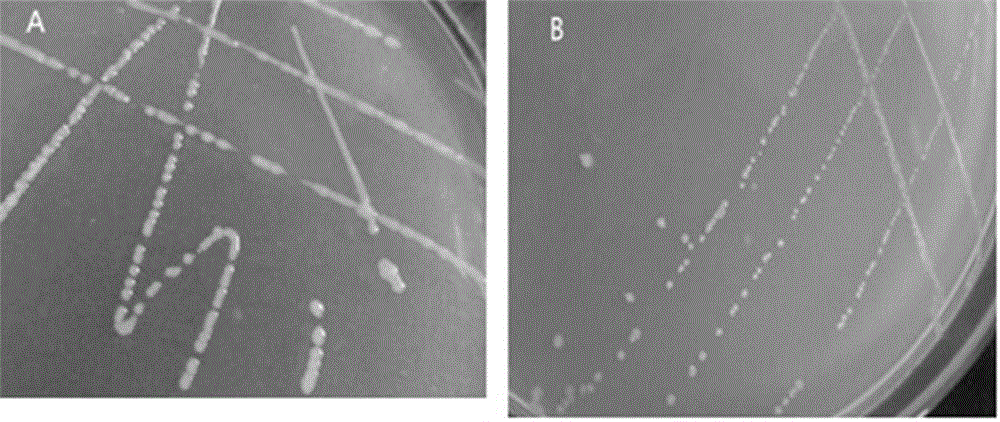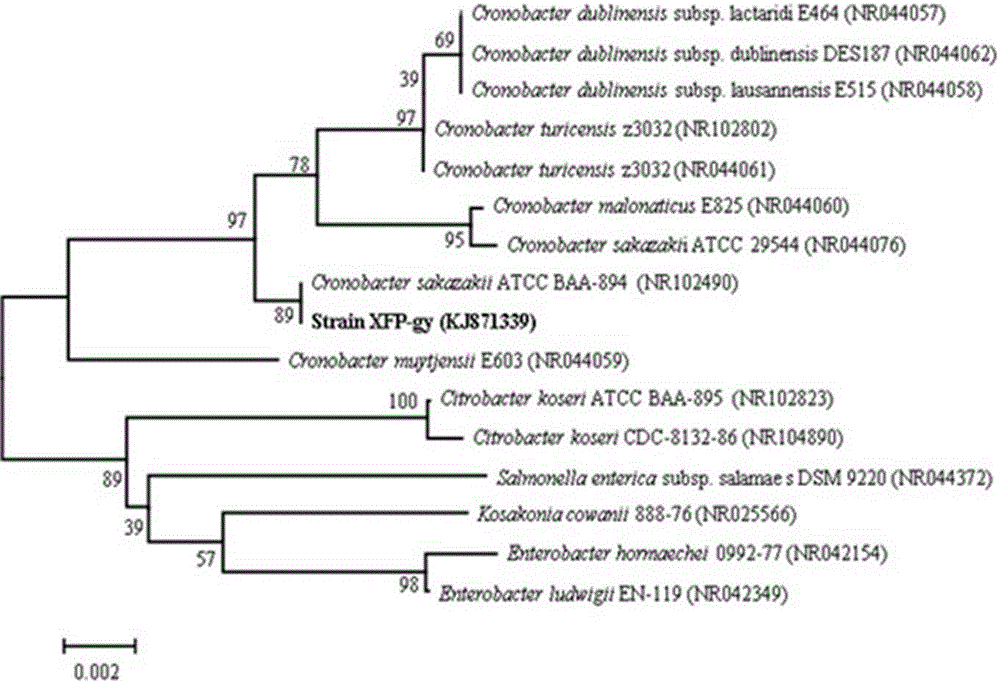Cronobacter and application thereof
A technology of Cronobacter and bacterial agents, applied in the field of microorganisms, can solve the problems of agricultural product appearance and quality damage, and achieve the effect of efficiently degrading pesticide residues, enhancing activity, and simple cultivation methods
- Summary
- Abstract
- Description
- Claims
- Application Information
AI Technical Summary
Problems solved by technology
Method used
Image
Examples
Embodiment 1
[0030] Example 1 screening strains
[0031] 1. Obtaining the strain
[0032] (1) Sample collection:
[0033] In June 2013, the fresh plant samples of Asteraceae plant Asteraceae growing next to the waste liquid pool in the Jiangsu Academy of Agricultural Sciences were washed with tap water to clean the dust and soil on the surface of the plants, dried naturally, and surface disinfection: soaked in 75% alcohol for 3- 5min, then rinsed with sterile water 3-4 times, with 2.5% NaClO 2 Rinse for 2-5min, wash with sterile water 5 times;
[0034](2) Isolation and screening of bacterial strains: the roots, stems, and leaves of P. aeruginosa were collected for tissue grinding, the juice was absorbed and evenly spread on enriched medium plates, and cultured at 30° C. in the dark for 2-7 days.
[0035] (3) Strain enrichment culture: After the colony grows, pick a single colony and streak it on the inorganic salt medium (MSM) containing chlorpyrifos (the content of chlorpyrifos is 50mg...
Embodiment 2
[0043] Embodiment 2 prepares XFP-gy bacterial agent
[0044] 1. Strain activation: pick the Cronobacter XFP-gy obtained in Example 1 to the culture medium for strain preservation, streak at 30°C, pick a single colony for two times (24 hours each), and then pick A single colony is cultured in the strain activation medium at 30°C, 150-200rpm shaker for 12-24h;
[0045] 2. Preparation of liquid seeds: inoculate the bacteria species activated in step 1 according to the inoculum volume of 1% of the volume of the seed medium in the fermenter equipped with the seed medium, and cultivate in air at 25-38°C for 16-24h to obtain liquid seeds;
[0046] 3. Liquid fermentation: Inoculate liquid seeds into a fermenter equipped with seed medium, the inoculation amount is 1% of the volume of the medium, and culture at 30-35°C and 150rpm in the dark for 4-6 hours to obtain live bacteria Cultures;
[0047] 4. Bacterial agent preparation: Take 50ml of live bacterial culture and centrifuge at 4...
Embodiment 3X
[0048] Example 3 XFP-gy inoculant degrades chlorpyrifos under in vitro conditions
[0049] 1. Inoculate 2ml of the XFP-gy microbial agent obtained in Example 2 into 100ml of MSM medium, add chlorpyrifos to a final concentration of 20mg / L, and measure the initial OD of the medium 600 value and chlorpyrifos content; at the same time, the culture medium not inoculated with XFP-gy bacterial agent (adding the same volume of sterile saline as bacterial agent) was used as the control group, and each treatment was repeated 3 times;
[0050] Both the control group and the experimental group were cultured at 30°C and 200rpm in the dark, and samples were taken after 9 days to measure the OD 600 Value and chlorpyrifos residual amount, found that the residual amount of chlorpyrifos in the experimental group was 4.43mg / L on the 9th day, and the degradation rate reached 77.28%. The degradation rate is only 0.8%.
PUM
 Login to View More
Login to View More Abstract
Description
Claims
Application Information
 Login to View More
Login to View More - R&D
- Intellectual Property
- Life Sciences
- Materials
- Tech Scout
- Unparalleled Data Quality
- Higher Quality Content
- 60% Fewer Hallucinations
Browse by: Latest US Patents, China's latest patents, Technical Efficacy Thesaurus, Application Domain, Technology Topic, Popular Technical Reports.
© 2025 PatSnap. All rights reserved.Legal|Privacy policy|Modern Slavery Act Transparency Statement|Sitemap|About US| Contact US: help@patsnap.com


